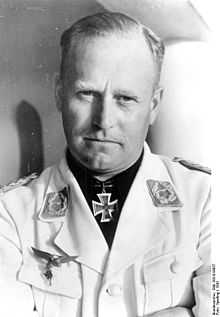Edgar Petersen
| Edgar Petersen | |
|---|---|
 | |
| Born |
26 April 1904 Straßburg, Elsaß |
| Died |
10 June 1986 (aged 82) Andechs, Munich |
| Allegiance |
|
| Service/branch |
|
| Rank | Oberst |
| Commands held | I./ KG 40, KG 40, Kommandeur der Erprobungsstellen |
| Battles/wars | World War II |
| Awards | Knight's Cross of the Iron Cross |
Edgar Petersen (26 April 1904 – 10 June 1986) was a German Luftwaffe bomber pilot and recipient of the Knight's Cross of the Iron Cross during World War II. The Knight's Cross of the Iron Cross was awarded to recognise extreme battlefield bravery or successful military leadership. Petersen was instrumental in converting the Focke-Wulf Fw 200 into what Winston Churchill called the "Scourge of the Atlantic" during the Battle of the Atlantic. He also served in the position of Kommandeur der Erprobungstellen (commander of all Luftwaffe test stations) as an Oberst later in the war, in which capacity from September 1942 onwards when its mandate for it to perform moderate-angle dive bombing missions had been rescinded by Reichsmarschall Hermann Göring,[1] to govern and manage the task of applying the substantial number of upgrades required for the troubled Heinkel He 177A, the Luftwaffe's only operational heavy bomber to make it combat ready, mostly focusing on the fire-prone DB 606 and DB 610 powerplants used for powering the He 177A's airframe.[2]
Awards
- Iron Cross (1939) 2nd and 1st Class
- Knight's Cross of the Iron Cross on 21 October 1940 as Major and Gruppenkommandeur of the I./Kampfgeschwader 40[3][4]
- Mentioned twice in the Wehrmachtbericht (3 October 1940, 20 June 1941)
Wehrmachtbericht references
| Date | Original German Wehrmachtbericht wording | Direct English translation |
|---|---|---|
| Thursday, 3 October 1940 | Eine Gruppe eines Kampfgeschwaders unter der Führung von Major Petersen, die sich schon im Norwegen-Feldzug besonders auszeichnete, hat in den letzten Wochen auf langen, bei jeder Witterung durchgeführten Feindflügen, die oft bis weit in den Atlantik hineinführten, rund 90 000 BRT feindlichen Handelsschiffraum versenkt und über 40 000 BRT schwer beschädigt, oft im Tiefangriff auf stark gesicherte Geleitzüge.[5] | A group of a bomber wing under the command of Major Petersen, who particularly distinguished themselves earlier in the Norwegian campaign, in recent weeks on long sorties carried out in all weathers conditions, which often went far into the Atlantic, has sunk about 90 000 GRT merchant shipping and severely damaged over 40 000 GRT often in low-level attacks on heavily guarded convoys. |
| Friday, 20 June 1941 | Eine Gruppe eines Kampfgeschwaders unter Führung von Major Petersen und später von Hauptmann Fliegel vernichtete seit Mitte April 1940 durch rastlose kühne Angriffe gegen die britische Versorgungsschiffahrt um England bis weit in den Atlantik hinaus insgesamt 109 Handelsschiffe mit rund 636 000 BRT und beschädigte weitere 63 Schiffe durch Bombentreffer schwer.[6] | A group of a bomber wing under the leadership of Major Petersen and later by Captain Fliegel destroyed since mid-April 1940, in restless and daring attacks against British supply shipping near England reaching far into the Atlantic, a total of 109 merchant ships totalling 636 000 GRT and severly damaged another 63 ships with bomb hits. |
See also
Siegfried Knemeyer, a subordinate of Oberst Petersen, who later served with the United States Air Force for over 30 years
References
- Citations
- Bibliography
- Fellgiebel, Walther-Peer (2000). Die Träger des Ritterkreuzes des Eisernen Kreuzes 1939–1945 – Die Inhaber der höchsten Auszeichnung des Zweiten Weltkrieges aller Wehrmachtteile [The Bearers of the Knight's Cross of the Iron Cross 1939–1945 — The Owners of the Highest Award of the Second World War of all Wehrmacht Branches] (in German). Friedberg, Germany: Podzun-Pallas. ISBN 978-3-7909-0284-6.
- Forczyk, Robert (2010). Fw 200 Condor Vs Atlantic Convoy, 1941–43. Oxford; Long Island City, NY:: Osprey Publishing. ISBN 978-1-84603-917-1.
- Griehl, Manfred; Dressel, Joachim (1998). Heinkel He 177 – 277 – 274. Shrewsbury, UK: Airlife Publishing. ISBN 1-85310-364-0.
- Kaiser, Jochen (2011). Die Ritterkreuzträger der Kampfflieger—Band 2 [The Knight's Cross Bearers of the Bomber Flyer—Volume 2] (in German and English). Bad Zwischenahn, Germany: Luftfahrtverlag-Start. ISBN 978-3-941437-09-8.
- Scherzer, Veit (2007). Die Ritterkreuzträger 1939–1945 Die Inhaber des Ritterkreuzes des Eisernen Kreuzes 1939 von Heer, Luftwaffe, Kriegsmarine, Waffen-SS, Volkssturm sowie mit Deutschland verbündeter Streitkräfte nach den Unterlagen des Bundesarchives [The Knight's Cross Bearers 1939–1945 The Holders of the Knight's Cross of the Iron Cross 1939 by Army, Air Force, Navy, Waffen-SS, Volkssturm and Allied Forces with Germany According to the Documents of the Federal Archives] (in German). Jena, Germany: Scherzers Miltaer-Verlag. ISBN 978-3-938845-17-2.
- Die Wehrmachtberichte 1939–1945 Band 1, 1. September 1939 bis 31. Dezember 1941 [The Wehrmacht Reports 1939–1945 Volume 1, 1 September 1939 to 31 December 1941] (in German). München, Germany: Deutscher Taschenbuch Verlag GmbH & Co. KG. 1985. ISBN 978-3-423-05944-2.
External links
| Military offices | ||
|---|---|---|
| Preceded by Oberstleutnant Hans Geisse |
Geschwaderkommodore of Kampfgeschwader 40 April 1941 – September 1941 |
Succeeded by Oberstleutnant Dr. Georg Pasewaldt |
| ||||||||||